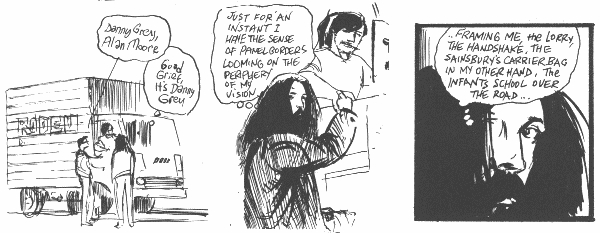As I think I’ve mentioned here before, Eddie Campbell is one of my favourite cartoonists, perhaps the best one currently working in comics. He may be best known for his work on Alan Moore’s massive From Hell project, but for me it’s a toss-up between Bacchus and Alec as to what is his best work. Today it’s Alec, as I’ve just heard about the massive new collection that’s going to come out this September. I’ve always felt that the series hasn’t been as widely appreciated as it should be, as there hasn’t been a good collection of it available for a long time, just short pieces in various anthology comics and long out of print “graphic novels” by long defunct publishers. As Campbell explains in this interview with Tom Spurgeon from late last year, the new collection will have everything and in chronological order:
TOM SPURGEON: I don’t think it fully registered with me before, but you have a massive collection of your autobiographical work coming out in 2009. I always thought that this was a natural for a book at some point and I look forward to it with a not insignificant smile on my face. Is there a reason this seemed attractive to you right now?
EDDIE CAMPBELL: The evolution of our medium has made this the right time. If you think back, at first we’d publish serial comics because that was what the economics permitted (all those “mini” and “maxi” series). Then we would gather the material into a book. The medium developed to the stage where a publisher could pay an author an advance to take himself away and make the whole book before showing any of it. We now find ourselves at an even more advanced stage, where several of a veteran author’s books are gathered into a huge compendium. Thus Will Eisner’s Life in Pictures, which collected his various books that had an autobiographical element, Gaiman’s Absolute Sandman, Gilbert Hernandez’ Palomar, etc.
SPURGEON: How did plans for this particular format come together?
CAMPBELL: Chris Staros at Top Shelf has been wanting to do the book for several years, since those others I just mentioned started appearing. In the meantime I’ve been gradually making digital scans of the pages for the French editions, knowing that all the time I was building toward using these in my own big collection. It is a lot of work after all, scanning 640 pages, especially with all the zip-a-tones, trying to avoid and eliminate moiré patterns. I’m probably now the expert on doing that stuff.
SPURGEON: When did new comics become a part of those plans?
CAMPBELL: The funny thing is that the way I started putting it all together isn’t quite the way it’s ended up. I had the six books (the King Canute Crowd, Graffiti Kitchen, How to Be an Artist, Little Italy, The Dance of Lifey Death, and After the Snooter,) arranged in a chronology that follows actual time rather than the order in which the books were drawn, and then I had a large 80-page section at the end which rounded up a lot of short pieces and some unfinished works which are still worth reading as they stand. But the more I looked at the pages I started seeing an epic sweep in which characters grow older, with a real sense of time passing. It’s ironic that in the comic book medium terminality has come to be seen as a holy grail, the notion of a thing being complete in itself (as in a “novel”), when the true essence of the comic strip is the very opposite, the concept of the eternal present. The greatest daily comic strips had no end. Conceptually, allowing for no interference by extramural forces, a strip may run forever (Like Gasoline Alley). Of course nowadays that quality has been usurped by the television soap opera. Given the dumbassed nature of comic books, the highest measure of commitment to quality, or terminality, that a writer can have is the determination to show characters being killed.
But I’ve wandered off the point. I saw this shape within the book and I shifted a few of the essential short things into their chronological positions and threw the rest out, then I saw the chance to complete the implied sequence by adding another book that brings things up to date. So we now have an all-new 35-page book at the end titled “The Years Have Pants”, which has also become the title for the whole compendium, since it fits so well. But the new book is in no way a conclusion, for it introduces a bunch of new developments that point to resolution outside of the text. I’ll also mention that there are half a dozen other unpublished pages included in the compendium.

